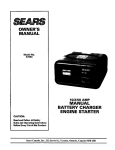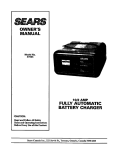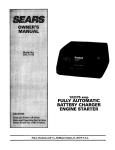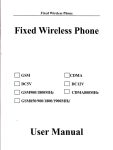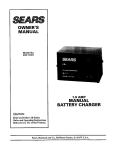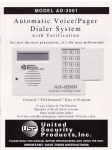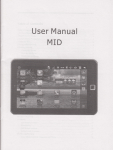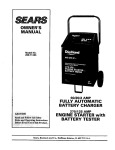Download Sears 200.71211 Owner`s manual
Transcript
SEARS OWNER'S MANUAL Model No. 200.71211 10/2/50 AMP MANUAL BATTERY CHARGER ENGINE STARTER CAUTION: Read and Follow All Safety Rules and Operating Instructions Before Every Use'of this Product. Sears, Roebuck and Co., Hoffman Estates, IL 60179 U.S.A. Table Of Contents Warranty .................................................................. 1 Important Safety InstrucUons .................................. Parts ......................................................................... 2 3 Setting the controls .............................................. 6 Charging y_)ur battery .......................................... 6 Before Using Your Battery Charger ........................ 4 Calculating charge time ........................................ 8 Plugging it in ........................................................ 4 Using the engine start feature ............................... 9 4 Maintenance and care .......................................... 9 Using an extension cord ....................................... Preparing your battery to be charged ................... 5 Using Your Battery Charger .................................... Troubleshooting ..................................................... Please read this Owner's Manual before using your Battery Charger The Sears model 200.71211, Manual Battery Charger/Engine Starter, offers a wide range of features to accommodate the needs for home or light commercial use. This manual will show you how to use your charger safely and effectively. Please read and follow these instructions and precautions carefully. Warranty FULL TWO-YEAR WARRANTY If, within two years fTom the date of purchase this battery charger fails due to a defect in materials or workmanship, simply RETURN IT TO THE NEAREST SEARS STORE IN THE UNITED STATES, and Sears will repair or replace it_fTee of charge. This warranty gives you specific legal rights, and you may also have other rights which vary from state to state. Sears, Roebuck and Co,, Dept 817WA, Hoffman Estates, IL 60179 6 10 Important Safety - SAVE THESE Instructions INSTRUCTIONS • Read all instructions and cautions printed on the battery charger, battery, and vehicle or equipment using battery. - • Do not disassemble charger. Take it to a qualified service professional if service or repair is required. Incorrect assembly may result in fire or electrical shock. • Use charger only on lead-acid type rechargeable batteries, such as those used in cars, trucks, tractors, airplanes, vans, RV's, trolling motors, etc. This charger is not intended to supply power to a low voltage electrical system other than in an automotive application. • To reduce risk of electrical shock, unplug the charger from the outlet before attempting any maintenance or cleaning. •Always charge battery in a well ventilated area. • Use only attachments recommended or sold by manufacturer. The use of attachments not recommended by the manufacturer may result in fire, electric shock, or injury. Help us help you Remember: • Place charger as far away from battery being charged as the charger cables will permit. • Never touch the battery clamps together when the charger is energized. • Do not expose charger to rain or snow. • Never charge a frozen battery. If battery fluid (electrolyte) becomes frozen, bring battery into a warm area to thaw before you begin charging. • Never allow battery acid to drip on charger when reading specific gravity or filling battery. • Never set a battery on top of the charger. • Never place charger directly above battery being charged. The gases from the battery will corrode and damage the charger. • Never operate charger if it has received a hard blow, been dropped, or otherwise damaged. Take it to a qualified professional for inspection and repair. • Be sure to position the charger power cord to prevent itfrom being stepped on, tripped over, or damaged. • Never pull out the plug by the cord when unplugging the charger. Pulling on the cord may cause damage to the cord or the plug. • Do not operate the charger if it has a damaged power cord or plug. Have the cord replaced. • Never use charger for charging dry-cell batteries that are commonly used with home appliances. These batteries may burst and cause personal injury. Personal Safety Precautions For your own personal safety, please follow the following precautions: • Wear complete eye and clothing protection when working with lead-acid batteries. • Be sure that someone is within range of your voice to come to your aid if needed while you work with or are near a lead-acid battery. • Have plenty of fresh water and soap nearby for use in case battery acid contacts your eyes, skin, or clothing. If this happens, was h immediately with soap and water. Then get medical attention. • Avoid touching your eyes while working with a battery. Acid particles (corrosion) may get into your eyes. If this occurs, flush eyes immediately with running cold water for at least 10 minutes. Then immediately get medical attention. • Remove all personal metal Items from your body, such as rings, bracelets, necklaces, and watches while working with a lead-acid battery. A battery can produce a short circuit current high enough to weld a ring (or the like) to metal, causing a severe burq. • Take care not to drop any metal tool or metal object onto the battery. This may spark or short circuit the battery or another electrical device that may cause an explosion. • Always operate your battery charger in an open, well ventilated area. • Never smoke or allow a spark or flame in the vicinity of the battery or engine. Batteries generate explosive gases. • Neutralize any acid spills thoroughly with baking soda before attempting to clean up. 2 Parts This section shows an illustration of your battery charger. Use it to become familiar with where all the parts are located, and what they look like. 13 Replacement Parts List Sears 71211 Item Deeedpflon 1 Cover Part Number 3799001402 2 3 Heatslnk/Dlode Assembly Base 2299000846 3799001382 4 6 ACPowerCord Transformer 90026055 93026312 6 Output Cable 3899000515 7 8 CircuitBreaker(20A) 50AClamp(1) 3999000072 2299000248 SlaevlngRed(2) required Sleeving Black(2) required Meter SwitchSPDT 0399000007 0399000008 5399100092 04990C0031 FrontPanel Decal 3799001392 0899000532 13 Handle 3599000240 14 15 Screw8-18x3/8"141 5181806256 OwneCs ManualandPertsUst(NotSho_)00000005:10 9 10 ,11 12 12 11 lO Wiring diagram BLACK- .. [] [] / / / / / SID[ VZEW OF 91fZTCH 3 Before Using Your Battery Charger It is important to understand your charger's requirements. This section will tell you about your charger's electrical requirements and how to prepare a battery for charging. Plugging it in Your charger should be grounded to reduce the risk of electrical shock. Your charger is equipped with an electrical cord that has an equipment grounding conductor and a grounding plug designed to be used on a 120 volt circuit. The plug must be plugged into an outlet that has been properly installed and grounded in accordance with all local codes and ordinances. A TEMPORARY adapter may be used to connect the charger to a two-pole outlet if a properly grounded outlet is not available. Use the adapter ONLY until a properly grounded outlet can be installed by a qualified electrician. ® DANGER: Before using an adapter as illustrated, be certain that the center screw of the outlet plate is grounded. The green colored grounding clip of the adapter must be attached by a screwto a properly grounded outlet. If unsure whether outlet is properly grounded, contact a professional electrician. If necessary, replace the original outlet cover screw with a longer one that will secure the grounding clip to the outlet cover and make a ground connection to the grounded outlet. Using an extension cord The use of an extension cord is not recommended. If you must use an extension cord, please make sure that you follow these guidelines: • Make sure that the pins on charger's power cord fit firmly into the extension cord, and that the extension cord fits firmly into the receptacle. • Use only 3-conductor (grounded) extension cord when necessary. • Check that the extension cord is properly wired and in good electrical condition. • Make sure that the wire size is large enough for its length and for the AC ampere rating as specified in the accompanying chart. Length of Cord, In Feet 25 50 100 150 AWG* Size of Cord 18 18 16 14 *AWG_Ammtcan 4 Wire Gauge Preparing your battery to be charged It is important that you read and follow these guidelines while you are preparing to charge your battery. • Make sure that you have a 12 volt lead-acid battery. • Clean the battery terminals. Be careful to keep corrosion from getting in or around your eyes, • If you have a battery with removable cell caps, if required, add distilled water to each cell until the battery acid reaches the level recommended by the manufacturer. This will help purge excessive gases from the cells. Be careful not to overfill. If you have a sealed battery without cell caps, no action is necessary. Continue to the next step listed below. • Take time to read all battery manufacturer's specific precautions, such as removing or not removing cell caps while charging, and recommended rates of charge. • Wear safety glasses. See additional "Personal Safety Precautions" on page 2. • Be sure that the area around the battery is well ventilated while it is being charged. If ventilation is poor, gas can be manually blown away by using a piece of cardboard or other non-metallic material as alan. • If it is necessary to remove the battery from the vehicle to charge it, always remove the grounded terminal from the battery first. A spark may be caused if all accessories in the vehicle are not completely turned off. NOTE: A marine battery installed in a boat must be removed and charged on shore. 5 Using Your Battery Charger For best results from your battery charger, learn to use itproperly. This section tells how to set the contmb and how to charge a battery in or out of the vehicle. Setting the SELECTOR Controls SWITCHES: A 3-way switch is used to select the 2-AMP or the 10-AMP charge rate or the ENGINE START feature. AMMETER: The AMMETER indicates the measured amount of amperes being drawn by the battery. When you first start charging a battery, the reading will be high, with the needle near 10 using the 10 amp charging rate. As the battery charges, the needle will fell to about 4 or 5 amps, indicating a charged battery. I[ 10 AMP roll 2 AMP ENGINE START At the 2 amp charging rate you will see little needle movement. When using the ENGINE START feature, the needle will swing into the Start (red) area of the scale while cranking the engine. The percent of charge scale is intended as a visual aid to help simplify reading the state of charge of the battery. The meter is scaled for use with the 10 amp charge rate only. For the 2 amp charge rate use the red triangle. The percent of charge is based on current drawn by the battery. For this reason accuracy will vary with the size and battery type. Charging Charging Your a battery Battery in the vehicle: 1. Arrange the power cord and charging leads carefully to avoid damage that could be caused by the hood, door, or moving engine parts. 2. Keep clear of fan blades, belts, pulleys, and other parts that can cause injury. 3. Check the polarity of the battery posts as indicated on the battery case: POSITIVE (POS, P, or +) and NEGATIVE (NEG. N or-). NOTE: The positive post on top-post batteries is usually larger then the negative post. 4. Identify which battery post is ground or connected to the chassis. THE NEGATIVE POST IS NORMALLY THE ONE THAT IS GROUNDED. 5. To charge a negaUve grounded post eyatem: Connect the red (POSITIVE) battery charger clamp to the ungrounded POSITIVE (POS, P, +) post of the battery. Then connect the black (NEGATIVE) clamp to a heavy, unpainted metal part of the chassis or engine block, away from the battery. Do not connect clamp to carburetor, fuel lines, or sheet metal parts. To charge a poattlve grounded poet system: Connect the black (NEGATIVE) battery charger clamp to the NEGATIVE (NEG, N, -) ungrounded NEGATIVEGROUNDEDSYSTEM post ofthe battery. Then connect the red (POSITIVE) clamp to a heavy, unpainted metal part of the chassis or engine block. Do not connect clamp to carburetor, fuel lines, or sheet metal parts. IMPORTANT: Wear safety glasses and face away from the battery while making connections. 6. Connecttheclamptothe batterypostandtwistor rockbackendforth to make a solid connection. This will help keep the clamps from slipping off the posts and causing sparks. 7. Select the charge rate with the Selector Switch then plug the power cord into a grounded AC outlet to begin charging. 8. The charger will not stop when the battery is fully charged. For this reason itis Importsnt to check charging progress frequently. Overcharging can damage a battery, you must monitor and unplug charger when battery is fully charged. 9. When the battery isfully charged, the AMMETER pointer will fall to about half the charge rate selected. Forspecific positions, refer to the "Ammeter" section in "Using your battery charger" on a page 6. 10. When the battery is fully charged, unplug the charger power cord before attempting to disconnect charger clamps. 11. Standing away from the battery, remove the charger clamps In this order: (1) from the chassis connection and, (2) from the battery post or terminal. 12. Clean and store the battery charger in a dry location. Charging your battery outside the vehicle: 1. Remove the battery from vehicle, making sure to disconnect grounded terminal first with all accessories and lights turned off in the vehicle. 2. Check the polarity of the battery posts as indicated on the battery case: POSITIVE (POS, P, +) and NEGATIVE (NEG, N, -). NOTE: On top-post batteries, the positive battery terminal usually has a larger diameter than the negative one. 3. Connectthe red (POSITIVE) chargerclamptothe POSITIVE post ofthe battery. Besureto rock the clip back and forth to make a solid connection. 4. Attach a 6-gauge (AWG) ora 4-gauge (SAE) insulated battery cable of at least 24-inches in length to the NEGATIVE battery post. This cable will provide a safer connection because aming and sparking will occur away from the battery. (The battery cable is not provided with the charger, but may be purchased at most automotive accessory oUtlets.) 5. Take the other end of the 6-gauge (AWG) or a 4-gauge (SAE)insulated 24-inch cable and, standing as far away from the battery as possible, connect the black (NEGATIVE) lead of the charger to the free end of the cable. Rock the clamp to make a solid connection. IMPORTANT: Wear safety glasses and face away from the battery while making this final connection. 6. Select the rate of charge with the Selector Switch end plug the power cord into a grounded AC outlet to begin charging. NEGATIVE POSITIVE BATTERY 24",6GAUGE CABLE CHARGER CORD TO POWER OU'R.ET 7. The charger will not stop when the battery is fully charged. For this reason it is important to check charging progress frequently. Overcharging can damage a battery, you must monitor and unplug charger when battery is fully charged. 8. When the battery is fully charged, the AMMETER pointer will fall to about half the charge rate selected. For specific positions, refer tothe "Ammeter" section in "Using your battery charger" on page 6. 9. When the battery is fully charged, unplug the charger power cord before attempting to disconnect charger clamps. 10. Stand away from the battery and remove the charger leeds from the NEGATIVE connection first, then from the POSITIVE battery post or terminal. 11. Clean and store the battery charger in a dry location. Calculating charge time The Chart Method Use the following table to more accurately determine the time itwill take to bring a battery to full charge. First, identify where your battery fits into the chart. • Small batteries -- motorcycles, garden tractors, etc. -- are usually rated in Ampere Hours (AH). For example; 6 to 12 AH, or 12 to 32 AH. • Batteries in cars and smaller trucks are usually rated in Reserve Capacity (RC), Cold-Cranking Amps (CCA), or both. SMALL BA'I-rERIES 6-12 • Marine, or deep-cycle batteries are usually rated in Reserve Capacity (RC). NR means thatthe chargersetting is NOT RECOMMENED. Find your battery's rating on the chart below and note the charge time given for each charger setting. The times given are for batteries with a 50-percent charge prior to recharging. Add more time for severely discharged batteries. AH 2-4 NR Motorcycle, garden tractor, etc. 12 -32 All 4- 10 NR 2O0 - 315 CCA 40 - 60 RC 11 - 14 2-27/8 315 - 55o CCA 60 - 85 RC 14 -18 27/s- 33/4 550 - 1000 CCA 85 -190 RC 18 - 35 33/4- 7 CAR/TRUCKS MARINE/DEEP CYCLE 80 RC 18 31/2 140 RC 27 51/2 160 RC 30 6 180 RC 33 7 The Hydrometer or Electronic Method To find the time needed to fully charge your battery, determine the battery's charge level with a hydrometer or electronic Percent-of-Charge Tester. The following table will help you convert hydrometer readings to percent of charge values. 1.265 100% 0% 1.225 75% 25% 1.155 25% 75% 1.120 0% 100% To calculate Ume needed for a charge: • Find the percent of charge needed. (A battery at 50 percent charge that will be charged to 100 percent needs another 50 percent (.50). • Multiplythe Amp Hour rating by the charge needed (.50) and divide by the charger setting (2 or 10 amp.s). Multiply the result by 1.25 and you'll have the approximate time needed, in hours, to bring the battery to full charge. • Add one additional hour for a deep-cycle battery. Example: Am,', Hour Ratin(:lx charoe needed x 1.25 = hours Charger Setting of charge 100 (AH Ratina) x .50 (charoe needed) x 1.25 = 6.25 10 (Charger Setting) hours When you know the percent of charge and the Amp Hour (AH) rating of your battery, you can calculate the approximate time needed to bring your battery to a full charge. 100 x .50 = 5 x 1.25 = 6.25 10 To convert Reserve Capacity to Amp Hours, divide Reserve Capacity by 2, and add 16: Amp Hours = Reserve Capacity 2 You would need to charge your lO0-Ampere Hour Battery for approximately 61/4hours at the lO-Amp charge rate using the above example. + 16 8 Using the engine start feature Your battery charger can be used to jump start your car if the battery is low. Follow these instructions on howto use the ENGINE START feature. t. Connect the charger to the battery. (Follow connecting instructions given in "Charging Your Battery" on page 6.) 2. Set the Selector Switch on ENGINE START. 3. Crank the engine for no more than 7 seconds. If it does not start, wait at least 4 minutes before cranking again. In extreme cold or if the battery is severely discharged, charge the battery for about 5 minutes in the 10 amp postion, before cranking the engine. 4. Aftertheenginestarts, unplug the charger power cord from the AC outlet. Then disconnect the charger from the battery. IMPORTANT: Do not try to start the engine without a battery in it. You could cause damage to the electrical system. If the engine does turn over, but never starts up, there is not a problem with the starting system, there is a problem somewhere else in the engine. STOP cranking the engine until the other problem has been identified and corrected. Maintenance and care A minimal amount of care can keep your battery charger working properly for years. 1. Clean the clamps each time you are finished charging. Wipe offany battery fluid that may have come in contact with the clamps to prevent COrrosion. 2. Coil the input and output cords neatly when storing the charger. This will help prevent accidental damage to the cords and charger. 3. Occasional cleaning of the case of the charger with a soft cloth will keep the finish shiny and help prevent corrosion. Troubleshooting Performance problems often result from little things that you can fix yourself. Please road through this chart for a )ossible solution if a problem occurs. PROBLEM POSSIBLE CAUSE SOLUTION/REASONS No ammeter reading. Clamps not making good connection. Check for poor connection at battery. Make sure clamps and posts are clean. 2-amp charge rate. Ammeter needle will indicate little activityat the 2-amp charge rate. No AC power reaching charger. Check AC outlet and extension cords for loose fitting plug. Check for open fuse or circuit breaker supplying AC outlet. Shorted battery clamps. Separate the clamps. Circuit breaker cycles when current draw is too high. Check for worn cables and replace if needed. Shorted battery. Have a Sears technician test the battery. Correct connections. Circuit breaker in charger cycles on and off with a clicking sound. Charger leads reversed on battery. Ammeter reads Jess than selected charge rate when charging. Charger makes a loud buzz or hum. Short stall: cycle when cranking engine. Extension cord too long or gauge to small. Use shorter or heavier extension cord. Battery has weak cell or sulfated plate. Sulfated battery will eventually take a normal charge if left connected. Ifthe battery will not take a charge, have it testedby a Sears technician. Battery is partially charged. Continue charging battery. Transformer laminations vibrate (buzz). Continue charging. Buzz is not abnormal. Shorted diode (hum). Have charger tested by qualified technician. Drawing more than 50 amps for a period equal to or less than 7 seconds. Crank time varies with the amount of current drawn from the charger. If cranking draws more than 50 amps, crank time may be less than 7 seconds. Failure to walt for 4 minutes :Wait 4 minutes before next crank. (240) seconds) between cranks. If the above solutions do not ellmlnate the problem... call toll-free_rom anywhere In the U.S.A. 1-800-SEARS-64 (1-800-732-7764) 7 AM to 4:30 PM CST Monday through Frlday 10 SEARS OWNER'S MANUAL Model No. 200;71211 10/2/50 AMP MANUAL BATTERY CHARGER ENGINE STARTER Forinformationabouttroubleshooting Calltoll-free fromanywhereinthe U.S.A. 7 amto 4:30 pm CSTMondaythroughFriday 1-800-SEARS-64 (1-800-732-7764) Forthe repairor replacement partsyouneed Call7 am - 7 pro,7 days a week 1-800-366-PART (1-800-366-7278) Forthe locationof a Sears Repair.,,,... ServiceCenterin yourarea Call24 hoursa day, 7 daysaweek 1-800-488-1222 When requesting service or ordering parts, always provide the following information: • Product Type • Model Number • Part Number • Part Description 0000000610-496 8£A S America's Repair Specialists












